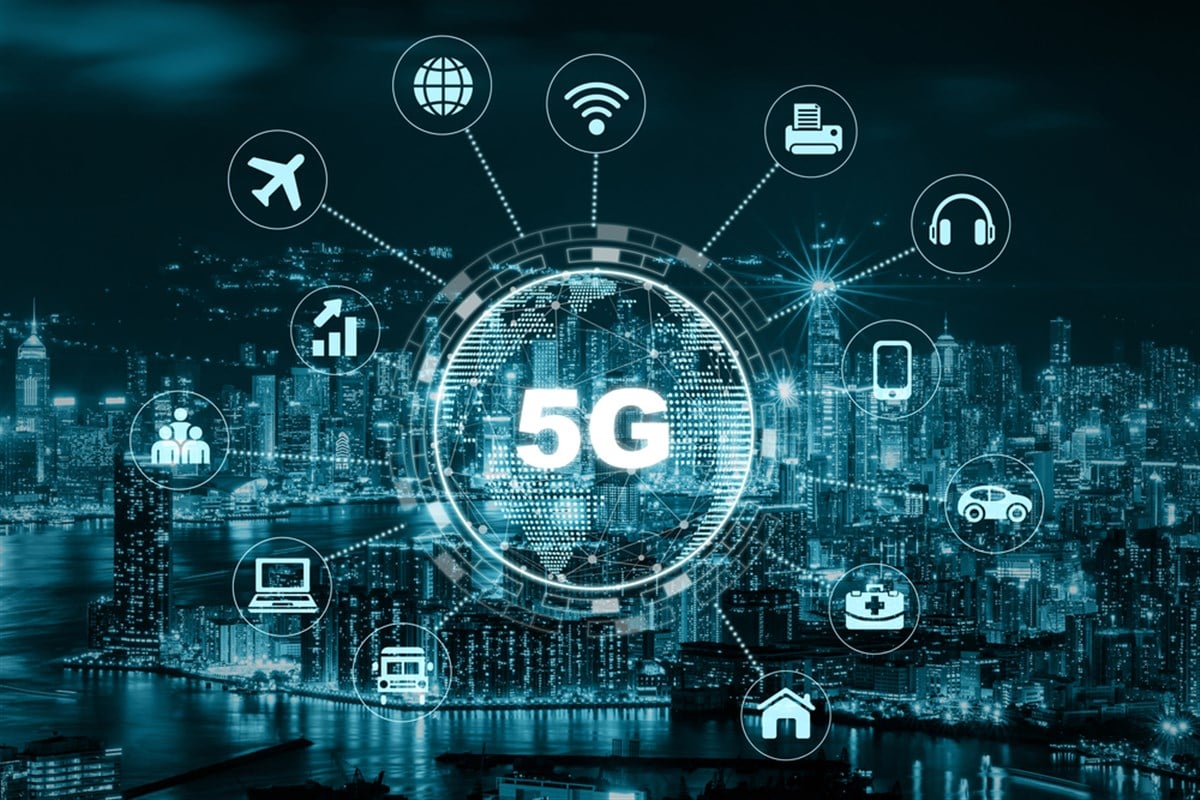 5G technology is one of those innovations that are so transformative that they create entirely new sectors for investors.
5G technology is one of those innovations that are so transformative that they create entirely new sectors for investors.
Investing in 5G is not merely about buying tech stocks or even specific niches like entertainment or streaming. Instead, investing in 5G encompasses all these areas and then some. This wireless technology promises more than just faster speeds and improved latency; it represents a foundational shift in how we connect and interact with technology.
By now, you've likely heard the term "5G wireless" numerous times, most likely by companies claiming the superiority of their 5G networks. If you own a 5G smartphone and don't notice a significant difference in speed, it's likely because your geographical area might not fully support 5G yet. However, by 2025, 5G is projected to cover two-thirds of the world. The 5G revolution is still in the rollout phase, and with tech stocks experiencing a market plunge, there are significant opportunities for those interested in investing in 5G stocks.
Keep reading to learn more about the 5G industry, key 5G stocks to invest in, and the various ways to gain exposure to 5G technology.
What Is 5G Technology?
Before investing in 5G stocks, it's important to understand what 5G technology is. 5G means it is the fifth generation of wireless technology. Each generation of wireless technology has progressively reduced latency, which is the time it takes for a device to make an input request and receive a network response.
For consumers, reduced latency manifests as increased speed, but the implications of 5G extend far beyond faster internet. This enhanced speed is poised to drive growth in emerging fields such as artificial intelligence, autonomous driving, cryptocurrency mining, and the Internet of Things (IoT). Unlike previous generations, which primarily benefited individual users, 5G technology is set to deliver substantial advantages to businesses and national infrastructure.
Why Invest in 5G?
The primary reason to invest in any technology is to profit from its potential upside. By the end of 2023, 5G technology reached about 40% of the global population. But the coverage is uneven, with high-income countries having significantly more access than low-income regions. For example, 5G covers 89% of the population in high-income countries, but this figure drops below 10% in some lower-income regions like Africa and the Commonwealth of Independent States (CIS), which comprises former Soviet Republics.
5G technology offers a platform for innovation and efficiency, enhancing existing applications and opening the door to numerous new technologies and applications. QUALCOMM (NASDAQ: QCOM) estimates that 5G will enable up to $13.1 trillion in global sales activity by 2035. While the initial hype around 5G has peaked and somewhat subsided, the pandemic accelerated e-commerce and wireless broadband usage, hastening the move toward widespread 5G adoption. We are now in the phase where consumers and businesses are beginning to access and utilize 5G.
Despite current economic uncertainties, there is a resurgence in 5G interest and investment, indicating significant potential for growth.
Ways to Invest in 5G
When investing in 5G, you should consider three key areas: infrastructure, hardware, and service providers. Improved applications are indirect beneficiaries of 5G. For example, Apple's iPhone 14 has 5G capabilities, but investing in Apple Inc. (NASDAQ: AAPL) is not a direct investment in 5G.
Infrastructure
Infrastructure companies build, upgrade, and service the networks operating 5G. Service providers can temporarily increase capacity by upgrading existing 4G networks while constructing the radio access network (RAN) towers and small-cell base stations needed for standalone 5G. Infrastructure investment also includes bidding for higher spectrum bands in auctions.
Hardware
Hardware companies supply key components for the equipment enabling, operating, and utilizing 5G. This includes mobile semiconductors, wireless chipsets, routers, optical fibers, and various semiconductor companies supplying processors for 5G usage.
Service Providers
Service providers include telecommunications and broadband wireless providers that operate the networks. They may own or lease network towers and provide access to 5G services, enabling consumers and businesses to use 5G-enabled devices.
Why Does 5G Create a Different Opportunity for Investors?
The first two generations of wireless technology (1G and 2G) allowed for wireless communication through voice, text (SMS), and multimedia messaging services (MMS). The introduction of 3G around 2000 enabled the smartphone revolution, increasing network bandwidth and allowing internet applications, audio, and video files. When 4G arrived about a decade later, it improved latency, allowing for faster uploads and enabling streaming music and video.
Unlike the transition from 1G to 4G, which did not require significant infrastructure changes, 5G demands substantial infrastructure investment, creating broader opportunities for investors.
How to Invest in 5G Technology
The deployment of 5G technology is transforming various sectors and industries, including semiconductors, equipment and infrastructure, real estate investment trusts (REITs), media companies and streaming services, video gaming, cloud computing, and healthcare. By investing in these companies and sectors, investors can capitalize on the potential of 5G technology, which is revolutionizing how we connect and interact with the digital world.
Semiconductors: Like most things tech, the building blocks of 5G are found in the tiny computer chips that allow processors to calculate data and execute commands. Companies that produce semiconductors include Qualcomm (NASDAQ: QCOM), NVIDIA (NASDAQ: NVDA), and Skyworks Solutions (NASDAQ: SWKS).
Equipment and Infrastructure: Before wireless signals reach connected devices, they must pass through a network of basic hardware, including fiber optic wires. Although this network is invisible to consumers, it's vital to enabling 5G. Equipment and infrastructure companies include Corning Inc. (NYSE: GLW) and Ciena Co. (NYSE: CIEN).
Real Estate Investment Trusts: 5G requires a new network of mini towers and other fixed-in-place assets, creating opportunities for REITs that own and operate the core real estate holdings needed to expand the 5G network. REITs include American Tower (NYSE: AMT) and Crown Castle (NYSE: CCI).
Media Companies and Streaming Services: Companies like Netflix (NASDAQ: NFLX), Disney (NYSE: DIS), Comcast Corporation (NASDAQ: CMCSA), and Warner Bros. Discovery, Inc. (NASDAQ: WBD) create and stream films, music, and other programming. 5G technology will also benefit social media companies.
Video Games: 5G technology will enable faster download speeds, lower latency, and enhanced cloud gaming experiences, making high-quality gaming more accessible and seamless on mobile devices. Video game companies include Activision Blizzard (NASDAQ: ATVI) and Electronic Arts (NASDAQ: EA).
Cloud Computing: 5G will enable faster and easier communication with cloud platforms and cloud-based applications. Companies in this space include Amazon (NASDAQ: AMZN) and Microsoft (NASDAQ: MSFT).
Healthcare: Telehealth and advancements in virtual reality will expand with 5G, improving remote patient care and diagnostics. Teladoc Health Inc. (NYSE: TDOC) and Medtronic (NYSE: MDT) are two healthcare companies using 5G to enhance their abilities to care for patients.
In addition, Telefonaktiebolaget LM Ericsson (NASDAQ: ERIC) and Nokia Oyj (NYSE: NOK) are two service prodivders that also provide infrastructure and produce semiconductors.
Another way to invest in 5G stocks is through an exchange-traded fund (ETF) that tracks an index of 5G-related stocks. While there aren't ETFs specifically labeled "5G ETF," several ETFs provide good exposure to areas likely to benefit from 5G like the Global X Internet of Things ETF (NASDAQ: SNSR) and the Defiance Next Gen Connectivity ETF (NYSEARCA: FIVG). For even less risk, you can consider ETFs focused on the infrastructure behind 5G, such as semiconductor-focused ETFs.
Pros and Cons of Investing in 5G
Like any stock, investing in 5G has benefits and drawbacks that you should consider.
Pros
- Diversification: 5G gives investors exposure to a wide range of sectors, many of which are among the hottest in the stock market.
- AI Applications: AI applications will become more efficient as 5G enables robust real-time data collection for device-to-device (D2D) and machine-to-machine (M2M) communications.
- Efficiency: 5G will make data-heavy and mission-critical applications more efficient and mainstream, from precision farming (agriculture technology) to smart cities and autonomous vehicles.
Cons
- Weak Economy Tailwinds: Investing in 5G can be risky during recessions and weak economic climates, as companies may cut capital expenditures, and consumers may reduce expenses, including upgrades to 5G-enabled devices or plans.
- High Buildout Costs: Financing 5G infrastructure buildout is expensive, especially with rising interest rates.
- Export Challenges: A strong U.S. dollar can negatively impact 5G companies exporting products overseas.
The 5G Revolution Is a Unique Opportunity
Investing in 5G technology allows you to be part of a transformative wave that promises to revolutionize various industries. Unlike previous generations of wireless technology, 5G is set to drive advancements far beyond faster internet speeds, impacting fields such as artificial intelligence, autonomous vehicles, and the IoT. As the technology continues to roll out and expand its reach globally, the potential for growth in 5G-related stocks remains significant.
Understanding the diverse landscape of 5G investments — from infrastructure and hardware to service providers and application beneficiaries — is crucial. By focusing on key players in the market and staying informed about industry trends and regulatory developments, you can strategically position yourself to capitalize on the growth of 5G. The current economic environment and the ongoing expansion of 5G coverage present a compelling case for both short-term gains and long-term growth potential. With careful analysis and a diversified approach, investing in 5G stocks can be a profitable addition to any investment portfolio.














